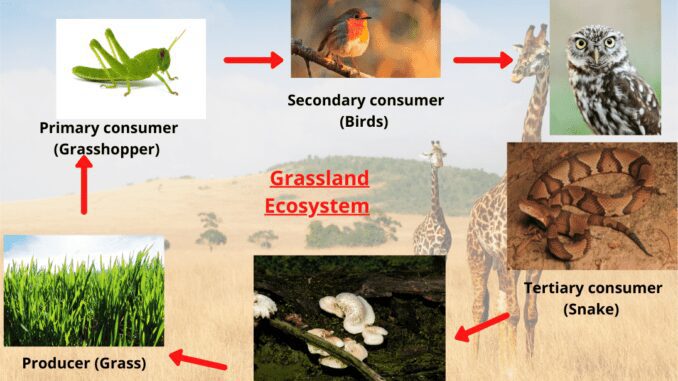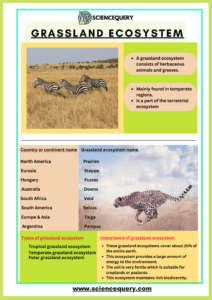
Introduction
There are different types of ecosystems depending on the temperature and other abiotic factors. Every ecosystem has different types of organisms based on abiotic factors. To sustain their lives these organisms depend upon each other for food and other live-sustaining sources. An interaction between living and non-living elements in any environment forms a system known as an ecosystem. The grassland ecosystem is one of the most important ecosystems of all.
In each ecosystem, there is a great variation between the climate, the weather, and other biotic and abiotic elements. For example, the biotic and abiotic elements of desert ecosystems are completely different from the biotic and abiotic elements of forest or grassland ecosystems.
On the other hand, aquatic ecosystems such as ponds and marine ecosystems have biotic and abiotic elements that are different from each other. Because of this difference, various types of ecosystems have been created in different parts of the world (1) & (4).
Grassland Ecosystem Video
Grassland ecosystem
- A grassland ecosystem is an area where mainly herbaceous and grass are found.
- About 20% of the earth’s surface is covered by grassland.
- This ecosystem is a part of the terrestrial ecosystem.
- Grassland ecosystems have developed mainly in temperate regions in the central part of the continent where the average annual rainfall is 70 to 100 cm.
- Here in the grassland ecosystem the amount of rainfall is higher than in the desert ecosystem but less than in the forest ecosystem.
- Grassland ecosystems receive irregular rainfall and usually do not have abundant rainfall.
- The temperature here is cold in winter and hot in summer.
- Grasses are the main producers of this ecosystem (1) & (3).
Geographical distribution
- Grasslands came into existence around 65.5 million years ago during the Cenozoic era.
- The grassland ecosystem can be seen in different parts of the world where the annual rainfall is about 70 to 100 cm.
- They are found in various parts of North America, South America, Australia, Europe, South Africa, Eurasia, etc.
- There are about eight types of grasslands in the Western Ghats, the western part of the Eastern Ghats, and other regions of India depending on the height.
- But below 600 m there has been an accumulation of different species of grass. On the other hand, 25 to 125 cm of rainfall in the Eastern Ghats is observed in grassland ecosystems (4).
Different names of the grassland ecosystem (4).
Country or continent name |
Grassland ecosystem name |
| North America | Prairies |
| Eurasia | Steppe |
| Hungary | Pustaz |
| Australia | Downs |
| South Africa | Veld |
| South America | Selvas |
| Europe | Taiga |
| Asia | Taiga |
| Argentina | Pampas |
Interesting facts about the grassland ecosystem
There are some characteristics of the grassland ecosystem. These are as follows
- The main plants of this ecosystem are different types of grasses like tor grass, blue moor-grass, false oat-grass, rough meadow-grass, cocksfoot, etc.
- This ecosystem is called the transitional zone as the grass is the predominant producer here, no big trees can be seen. Small trees can be seen in some places.
- The climate of the grassland ecosystem is very dry and the soil is very weak. This weak soil is not ideal for growing large plants. So small trees and grasses grow here.
- There are many tree species in the grassland ecosystem that grow very fast.
- Natural grassland ecosystems are generally warmer.
- The temperature in the grassland ecosystem ranges from 15°c to 35°c.
- The dry season in this ecosystem can last up to eight months.
- The annual rainfall of this ecosystem is 50 to 100 cm. As a result, grasses grow faster in this ecosystem.
- The appearance of grasses in this ecosystem changes with the season. As in winter, the grasses look rough and lifeless. During the rainy season, the grasses of this ecosystem change from pale brown to bright green (3) & (4).
Types of grassland ecosystem
Grassland ecosystems are divided into three parts based on climate (2) & (4). These are
1. Tropical grassland ecosystem
- Tropical grassland ecosystems extend up to about 20° on either side of the equator.
- The average rainfall of this grassland ecosystem is about 50 to 100 cm.
- The height of the grasses is about 1 meter to 3 meters.
- Huge diversity in the animal kingdom can be observed in tropical grassland ecosystems like deer, lion, giraffe, etc. are seen in the tropical grassland of Africa.
2. Temperate grassland ecosystem
- Temperate grassland ecosystems are formed mainly in the center of the continent where the average annual rainfall is 75 to 100 cm.
- Mainly found in Europe, Asia, and North America.
- Big bluestem, little bluestem, buffalo grass, Gama grass, etc. can be observed in this ecosystem.
- This ecosystem has buffalo, zebra, kangaroo, different species of birds, reptiles, and fish.
3. Polar grassland ecosystem
- Alpine or polar grassland ecosystems are located at higher altitudes.
- This ecosystem is covered with snow all year. Snowfalls and blizzards are often seen here.
- The temperature of these grassland ecosystems is usually below 10°C.
- The total annual rainfall of the polar grassland ecosystem is low (10 to 40 cm).
- Different species of grasses, algae, moss, lichen, etc. are found in this ecosystem. However, several small annual plants grow in the summer.
Component of grassland ecosystem
A grassland is a type of habitat with grasses and bushes. About one-fourth of the earth is covered by grassland. Most grasslands are located between forests and deserts. Like all ecosystems on earth, this ecosystem is made up of some abiotic and biotic components. These abiotic and biotic components of the ecosystem are described below (2) & (4).
Abiotic factors or components of the grassland ecosystem
The abiotic components of this ecosystem are soil, temperature, rainfall, and topography. All these abiotic factors greatly affect the grassland ecosystem.
1. Soil
The soil of this ecosystem is very fertile as it contains carbon, nitrogen, oxygen, phosphorus, etc. Tropical grassland ecosystems are mainly found in chernozem soils. However, laterite soils are found in river valley areas. On the other hand, temperate grassland soils are rich in organic matter. Chernozem and chestnut soils can be observed in this temperate region. In the Polar grassland ecosystem most of the time there is snowfall.
2. Temperature
Temperatures in some grassland ecosystems are often very high with an annual average temperature here is -20°c to 30°c. Tropical grassland ecosystems are both dry and humid. Therefore, they are hot all the time. The temperate grassland is cold in winter and hot in summer. And in the polar grassland, cold weather prevails throughout the year (4) & (5).
3. Rainfall
The annual average rainfall of grassland ecosystems is about 40 to 100 cm. Tropical grassland ecosystems receive the highest amount of rainfall. The amount of rainfall in the temperate grassland ecosystem is not very high. This ecosystem usually receives rainfall in summer. The amount of rainfall in the polar grassland ecosystem is very low (less than 25 cm) (2) & (5).
4. Topography
The topography is an abiotic element that affects an ecosystem. Topography refers to the height of a region. The height of the tropical grassland ecosystem is very high in some places and very low in some places. Temperate grassland ecosystems are usually located on flat land. And polar grassland ecosystems are observed at high altitudes (4) & (5).
Biotic factors or components
The biotic components of the grassland ecosystems are producers, consumers, and decomposers.
1. Producers
The grass is the main producer of this ecosystem some examples are tor grass, blue moor-grass, false oat-grass, rough meadow-grass, cocksfoot, etc. There are also a variety of small shrubs (2) & (4).
2. Consumers
Deer, mice, rabbits, cows, sheep, etc. are the primary consumers of the grassland ecosystem. They take the grass (producers) as food. Snakes, foxes, jackals, etc. are the secondary consumers. And hawks, owls, etc. are the tertiary consumers (2) & (4).
3. Decomposers
Penicillium, Mucor, Cladosporium, Rhizopus, etc., and different types of bacteria are the decomposers of a grassland ecosystem. All these fungi and bacteria cause the decay of the producers and consumers of the grassland ecosystem (2) & (4).
Importance of grassland ecosystem
- These grassland ecosystems cover about 20% of the entire earth. This ecosystem provides a large amount of energy to the environment.
- The grassland ecosystem soil is very fertile which is suitable for croplands or pastures. This ecosystem plays an important role in agriculture.
- Many plants and animals live together.
- This ecosystem maintains rich biodiversity.
- This ecosystem is highly diverse but less than forest ecosystems. So many tourism industries have developed around this ecosystem.
- Grassland ecosystems have some plants that prevent soil erosion. And interrupting the creation of the desert (4) & (5).
Today ecological changes are taking place in the environment due to natural and human activities. Landslides, floods, deforestation, storms, etc. are currently occurring which is causing extensive damage to the animals and plants living in this ecosystem destroying the balance. So it is very important to preserve this ecosystem to maintain both ecological balance and biodiversity will be preserved (4).

